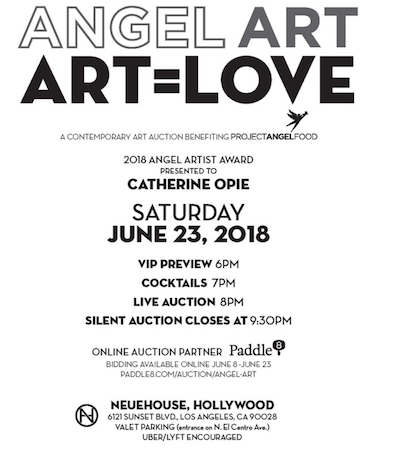Every day we learn — and experience — more about climate change with 300 animal and many more plant species now considered endangered just in California. Overwhelming realizations such as this are increasingly taken on by artists. The ideas are addressed in a quite personal way in a show of new paintings by Kirsten Everberg at 1301 PE in the mid-Wilshire district. The glossy pictures are so lush, their message might take a few moments to absorb. Birds and snakes, insects and flowers are painted in her trademark oil and enamel on panel, a medium that is shiny and vibrant.
The title of the show, Life Still, offers more than one meaning. This is life at this moment, life that is holding still but also still here. La Graciosa (2019) is an arrangement of lavender thistles and blooms is set before a yellow wall and window to the outdoors, where a ferret looks in. Grasshoppers are coupling under a blossom. A winning hand of cards lays on the table to emphasize the role of chance. (Very appealing cards of the artist’s unique design.)
This and other still lives were arranged by the L.A.-based artist who received her undergraduate and graduate degress in art from UCLA. They are set up in her architectural home, designed by Barbara Bestor, in Silverlake. They are intimately observed but they come from a lengthy lineage of art, especially the Golden Age of Dutch painting in 17th century. Artists chose flowers from different seasons of the year to symbolize the brevity and beauty of existance. Such paintings are called vanitas because they symbolize transcience and transcendence, the vanity of looking for internal, spiritual sustenance in the temporal assets of wealth or fame.
In the past, this referred to the lives of people, encouraging the search for faith in their time. Everberg’s asks us to consider our impact on the lives of animals and plants, whose survival as species is dependent on our behavior.
Rather than linger on that depressing thought, we can look to the painting themselves with their carefully integrated areas of color that puddle and swirl like liquified jewels yet coalesce as studies of nature within the context of daily life.
In this and other paintings, the animals are not portrayed in their actual proportions. Bugs are big, animals small. The effect is a bit jarring but accomplishes the desired result, making us look more closely for other clues to meaning.
Everberg brings us vanitas paintings for our times with a broken glass as fragility, a butterfly perched on a split pomegranite as a token of sundered faith. She is hardly the only contemporary painter to be returning to the still life traditions. Known for her past paintings that integrated memory and present reality, often within in architectural interiors, she now asks us to look at the present before it becomes our irretrievable history. The show continues through June 29.
More Information













